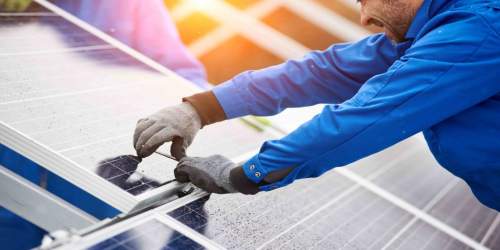Read Time : 3 Minutes
What are Silicon Solar Cells
I am text block. Click edit button to change this text. Lorem ipsum dolor sit amet, consectetu
How Do Silicon Solar Cells Work?
The main component of a solar cell is silicon, which has been used as a key part of electrical items for decades. Often referred to as ‘first generation’ solar panels, they currently make up over 90% of the solar cell market. The reason for the title of ‘first generation’ is because silicon solar cell technology had already started gaining traction on the 1950s. Therefore, it is the first form of solar cell technology. However, it should be noted that pure crystalline silicon is a poor conductor of electricity as it is a semiconductor material at its core. The silicon that is found in a solar cell has a number of impurities, so other atoms are purposely mixed in with the silicon atoms. This addresses the conduction issues because the newly mixed atoms improve the silicon’s ability to capture energy from the sun and convert it into electricity. For example, an atom of gallium has one less electron than an atom of silicon, while an arsenic atom possesses one electron more. When arsenic atoms are placed between silicon atoms, there will be extra electrons in the structure as a result. Therefore, an electron-rich layer will be formed. When you use gallium atoms instead, there is a lack of electrons. This means that a poor electron layer will be created. In a solar cell, the layers are positioned next to each other, and it is this which creates an electric field. When the sunlight hits the solar cells, the energy stimulates the electrons, and this leaves holes behind. These migrate to the electrodes in the cells because of the presence of the electric field. Thus, electricity is created.
COMPARE PRICES FROM LOCAL INSTALLERS
Compare prices from local companies fast & free
Enter your postcode to compare quotes from leading professionals. We promise to keep your information Safe & Secure. Privacy Policy
The Cost of Silicon Solar Cells?
It isn’t long ago that silicon solar panels were quite costly to purchase and install. This is because high quality and costly silicon were required for their creation. The process of purification for the silicon before adding gallium and arsenic atoms also added to this cost because it was time-consuming and expensive. In good news, however, the development of new technology meant that the use of cheaper and lower quality silicon was possible without affecting the overall quality of the solar cells. This means that silicon solar cells are now more affordable, and the price is continuing to drop. Plus, government subsidies have also contributed to the decline in price. The organic solar cell is looking to be an exciting new form of solar power in the near future. Cheaper and more efficient, it could be the next big thing for renewable energy.
The Limitations of Silicon Solar Cells
Silicon panels are not ideal for transportation due to the fact that they are very fragile as well as rigid. The parts are also still fairly expensive to purchase and manufacture, adding further complications to transportation. Other options, such as organic solar cells, are proving to be easier to transport and less expensive – which is all potentially exciting for the future.
Types of Silicon Solar Cells
Here are some of the types of silicon solar cell available to consumers.
Monocrystalline Solar Cells
Monocrystalline solar cells are also known as single crystalline cells. They are very easy to identify due to their dark black colour. Monocrystalline cells are made from a very pure form of silicon, making them the most efficient material for the conversion of sunlight into electricity. In addition to this, monocrystalline solar cells are also the most space-efficient form of silicon solar cell. Another advantage to the use of monocrystalline cells is that they last the longest of all silicon solar cells. Many manufacturers will offer warranties that last up to 25 years on these types of system. However, these superior benefits do come at a hefty cost – and that is quite a literal statement. Monocrystalline cells are the most expensive option out of all of the silicon solar cell types, primarily because the four-sided cutting system results in a great deal of waste. This can even be more than half of the silicon, which is huge. The cheaper alternative is polycrystalline or film cells.
Polycrystalline Solar Cells
Polycrystalline cells are also known as polysilicon and multi-silicon cells. They were the first solar cells to be developed in the industry at the start of the 1980s. Interestingly, polycrystalline cells do not undergo the same cutting process as monocrystalline cells. What happens instead is that the silicon is melted, and then poured into a square mould. This is what creates the square shape of the polycrystalline. One of the great benefits this process has is making the solar cells much more affordable, as hardly any silicone is wasted during the manufacturing process. However, they are less efficient than their single crystalline cell counterparts, and require a lot more space. This is due to the fact that the purity levels are lower in polycrystalline cells. Additionally, polycrystalline has a lower heat tolerance than monocrystalline. This means that they are unable to function as efficiently in high temperatures, which can be a huge disadvantage in hot climates.
Amorphous Solar Cells
The word ‘amorphous’ means shapeless. The silicon found in this solar cell is not structured or crystallised on a molecular level, unlike the other forms of silicon-based solar cell. In the past, these ‘shapeless’ solar cells were used for small-scale applications, like pocket calculators, because their power output was considerably lower. However, it was discovered that by stacking several amorphous cells on top of each other, the performance benefitted from a significant increase of up to 8%. The Amorphous silicon solar panels are a powerful line of photovoltaic systems, and their emergence is an exciting one. They differ from the regular crystalline silicon cells in terms of their output, structure, and manufacture. The cost of materials is lower as well, since these cells only require about 1% of the silicon that would have been used to produce a crystalline silicon-based solar cell. The development process for amorphous silicon solar panels has made them far more flexible and lightweight, making transportation and installation of these solar panels a lot less risky. A flexible, thin filmed, module means that these solar cells are even suitable for curved surfaces. Their applications are almost limitless. However, they do have one main drawback. They have a lower efficiency rate than other silicon-based solar cells. However, it is important to remain hopeful as the technology is still quite new, and so the efficiency rates are estimated to increase as technological advances are made in the near future. r adipiscing elit. Ut elit tellus, luctus nec ullamcorper mattis, pulvinar dapibus leo.
Find a local installer
Welcome to the biggest directory of UK renewable energy companies





 How Much do Solar Panel Systems Cost in 2024?
How Much do Solar Panel Systems Cost in 2024?







